In any venture, be it a huge corporation or a small startup, charting a clear course of action has always been important. A tremendous amount of aspects of business development can be challenging to handle. This is where a well-constructed product roadmap comes into play.
Normally, it is a complex documentation that encompasses various parts of the business, both current and future. Thus, in this piece, we will define the product roadmap as a term, explore its fundamental purpose as well as overview the process of creating one.
Defining a product roadmap
As the term is really popular, it is often misused or interpreted to the extent that it loses its original meaning. So, what is a product roadmap?
According to the product roadmap definition, at the core of it lies the logic of guiding your company, its product, or its service from ideation through execution. With the complex knowledge, analytics, and data it consists of, it helps companies navigate the complex terrain of customer needs, market dynamics, and technology trends.
A product roadmap is a strategic plan or visual representation that outlines the high-level plan for the development and evolution of a product over time. It serves as a guiding framework for product teams, stakeholders, and executives to understand and communicate the vision, goals, and direction of a product. The product roadmap tool typically covers a specific time frame, which can range from a few months to several years, depending on the product's complexity and industry.
Main types of product roadmaps
With the understanding of what is roadmap, let’s figure out different types of them. Depending on the mission, product roadmaps can vary in functionality and filling. Product companies can have different goals that are measurable and tracked using different methods. Hence, different types of product roadmaps fit different use scenarios.

Epics roadmap
First things first, in project management, epics stand for large chunks of work. Traditionally, they are broken down into stories, which essentially are milestones. Epics often cover multiple teams on multiple projects and can even be tracked on different boards.
Now, back to the topic. An epics roadmap manages upcoming work by grouping related features, tasks, or projects into cohesive units. This strategic planning tool proves invaluable in visualizing how work is distributed across multiple releases. It allows you to communicate your key focus areas effectively and aid in the decision-making process regarding prioritization. It empowers your team to tackle complex initiatives methodically by breaking them down into manageable epic-sized chunks.
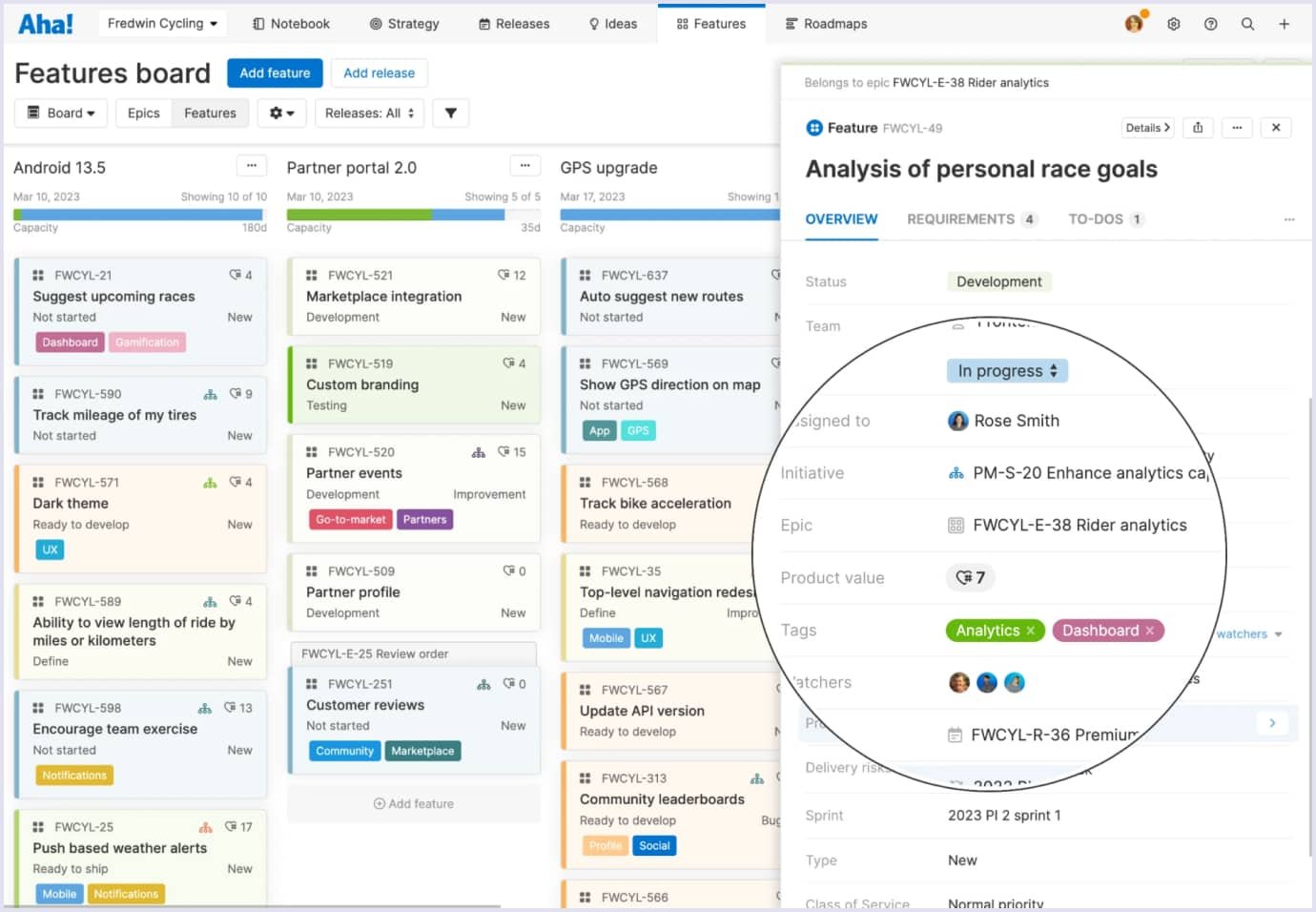
Features roadmap
When working with a new app, product, or website, a features roadmap is practically a must-have. Basically, it offers a clear timeline that unveils when new features or functionalities will be delivered to the product.
Essentially, the roadmap tool is a handy thing to track the development process and communicate details about what customers can expect and, most importantly, when they can expect it. Thus, it can be used in two ways.
One use case is for customers, as mentioned. With its help, the marketing team can share release dates, build up intrigue, communicate with the audience about it, etc.
Another use case is for internal teams. In this scenario, teams will be able to overview the product's evolution and see priorities, deadlines, and the current state of things.
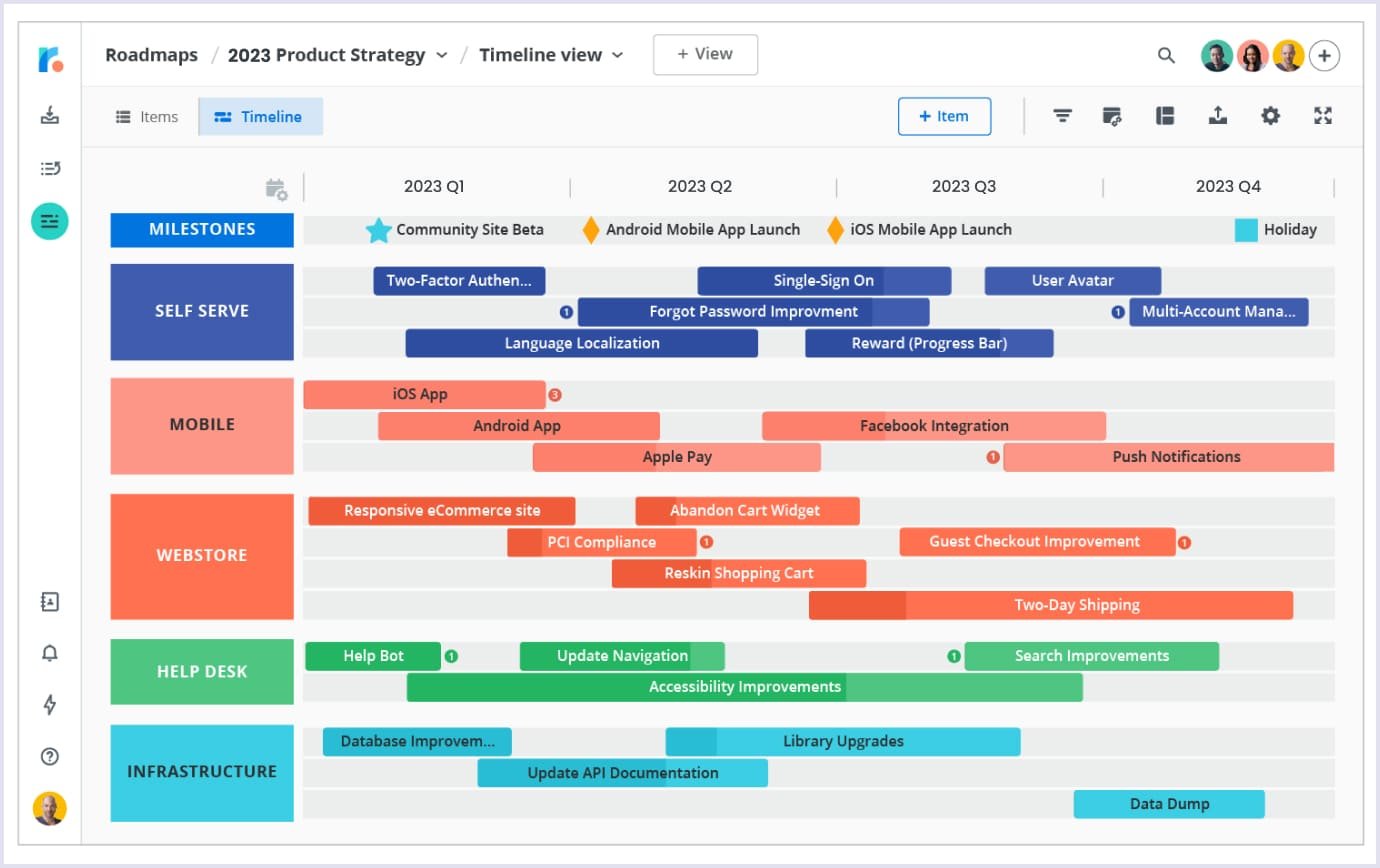
Portfolio roadmap
This roadmap type offers a panoramic view of planned releases across various products, all consolidated into a single, comprehensive display. This type is primarily a strategic tool with a high-level perspective, as it is extremely helpful to overview your business plans.
A well-developed portfolio roadmap can bring a lot to the table. For instance, it fosters more thoughtful decision-making, allows executives to effectively manage how product teams collaborate, and monitors the state of all processes, ensuring alignment with broader company objectives.
Release roadmap
Releases aren’t simple. While a freelance blog writer can release an article at any time, big companies and startups need to meticulously outline all processes before launching new releases into the market.
For this reason, there are release roadmaps that define what needs to happen, when it needs to occur, and who bears responsibility for its successful delivery. This roadmap allows you to effectively coordinate release activities seamlessly with cross-functional teams, including marketing, sales, and customer support, ensuring a harmonious and timely product launch.
Strategy roadmap
The strategy roadmap is like a big-picture plan for your product. It shows the important things you're doing to help your product reach its main goals. It's also the link between your product and your company's overall plan. When you show how well you're doing on these big goals to your leaders, it helps everyone understand where your product is going and how it fits into the company's big plans. It's a way to keep all the different teams working together and make sure your product's strategy matches the company's strategy.
So, why need different types of roadmaps after all? In layman’s terms, it is a multifaceted approach to product planning, from the granular details of features and releases to the strategic alignment of your product with the broader goals of your organization. Each roadmap serves its purpose, it is unique to certain scenarios and is simply a powerful project management tool.
Teams that use product roadmaps
Basically, roadmaps not only serve different purposes but are also created for different teams. Simply put, they facilitate certain processes in product development lifespan, and different teams can benefit from them. Let’s talk examples.
Internal roadmap for the sales department
Sales roadmaps primarily revolve around the introduction of novel features and the benefits they bring to customers. In some instances, they might even highlight significant customers who have expressed interest in these features, which can serve as valuable ammunition for sales discussions.
However, roadmaps for sales tend to have less focus on deadlines as there are lots of fluctuating aspects. Thus, you don’t need to bind your internal teams to potentially unattainable timeframes, which can lead to frustration and unrealistic expectations.
Internal roadmap for executives
These roadmaps show how teams' work helps the company reach its big goals and performance metrics. Speaking of timelines, they can cover a month or a quarter, or even years, as they primarily show a big, zoomed-out picture and don't dive into all the little details of tasks and stories.
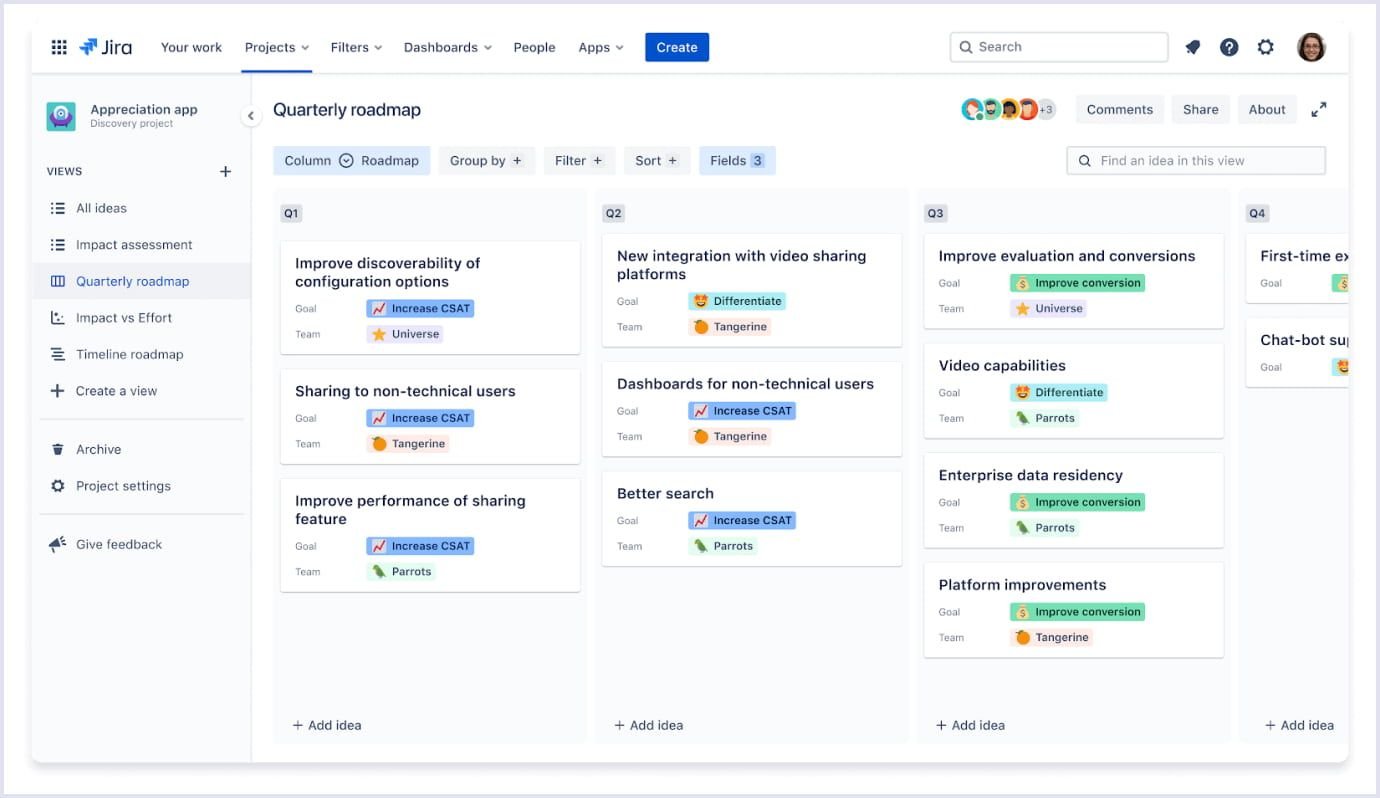
Roadmap for the development team
The development phase is one of the most intricate aspects of any project, and it demands effective management and direction. In this context, a product management roadmap proves to be an invaluable tool. The beauty of roadmaps is their adaptability; you can tailor them to suit your team's preferences and working style.
These roadmaps typically encompass crucial information such as prioritized customer benefits, targeted release dates, and significant milestones. Their primary purpose is to provide development teams with a clear understanding of the product's strategy, its alignment with overarching objectives, and the rationale behind the prioritization of various initiatives.
Regarding the actual development work, it's advisable for teams to create a separate delivery plan that harmonizes with the broader product roadmap. Given the prevalence of agile methodologies in development, these plans often adopt a sprint-based approach, offering a detailed timeline with specific tasks and challenges clearly mapped out. This ensures that the development process stays on track, fostering efficiency and accountability.

External roadmap
Finally, out of all four, this is the only one that is created for the audience. These roadmaps excite customers, letting them know what to expect in the future. To do so, such roadmaps must provide general information about release dates of the main features of the product to intrigue and simply inform your users.
On the other hand, they can often work as proof that the company is trustworthy, it is working, and is planning something.
Nowadays, external roadmaps are quite common and can be met across various industries. For instance, they are common in the crypto world. Developers of new tokens or NFTs often release roadmaps to let their audiences know what to expect and when it is going to happen. Moreover, it serves as a safeguard, as people tend to develop more trust towards the product.
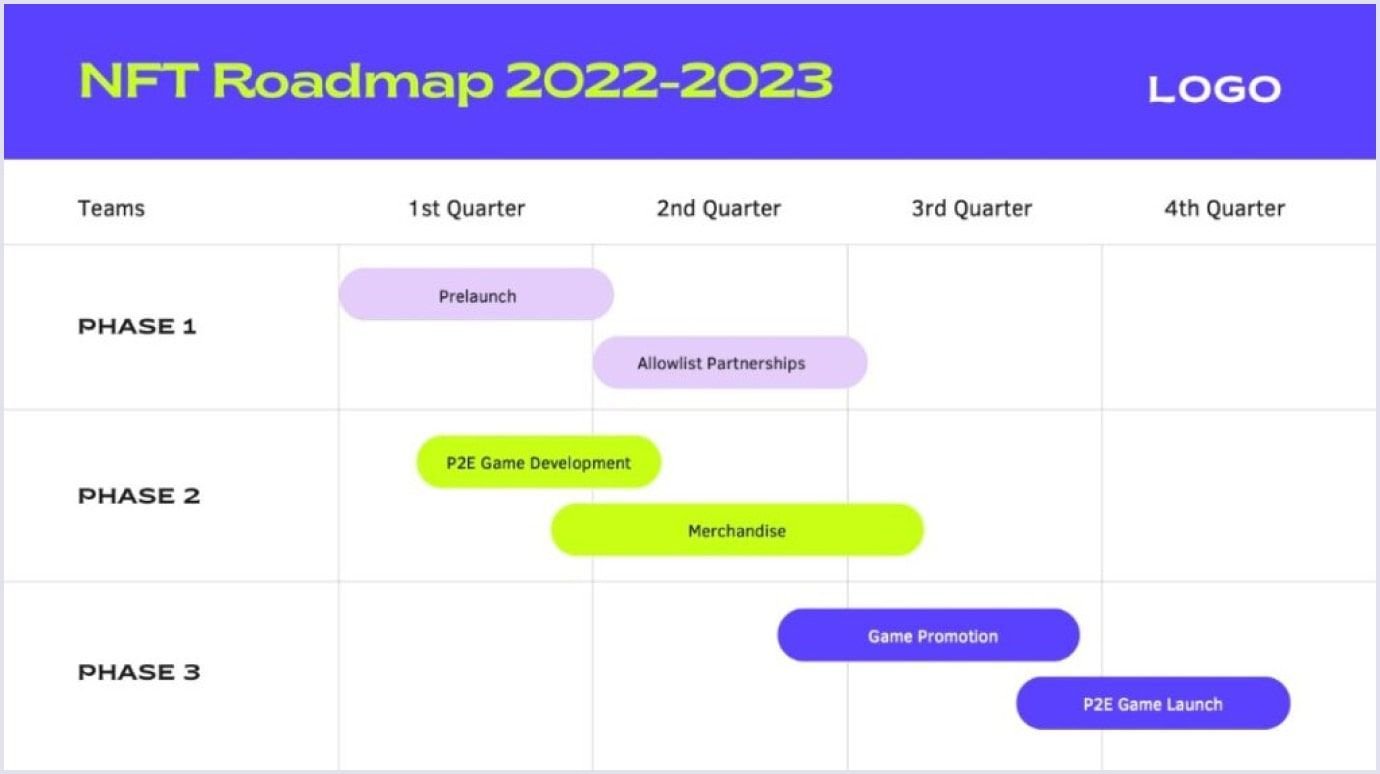
In the gaming industry, and in online games particularly, developers need to regularly update the game and provide new content so that players are constantly happy and engaged. Thus, the external roadmap is one such tool that developers use to inform players about newcoming content, collaborations, updates, or thematic events.

Product roadmap development process
As already mentioned, the content of a roadmap highly differs depending on the audience it gets created for. It also depends on the size and structure of an organization. Thus, knowing many different variables affect the end look of a roadmap, you will need to approach its creation carefully. To get into even greater detail, let’s overview each part the product roadmap template normally consists of.
Goals and objectives
When you wonder how to create a roadmap, the very first thing you should consider is the part where goals and objectives are outlined. As the name suggests, this part of the creation process defines goals that the product team aims to achieve.
Normally, they are aligned with the overall business strategy and customer needs. To build a roadmap, you should evaluate ideas based on key criteria, such as:
- Trajectories for market expansion;
- Insights and input from users;
- Organizational objectives;
- Limitations on resources and effort.
Once these elements are comprehended, product teams can collaborate to begin ranking initiatives on the roadmap. To simplify the process of identifying a starting point, consider envisioning the future of your product. Analyze which problems you create a product roadmap to solve and how it complements your business objectives.
Additionally, you can use a simple technique called SMART goals. Essentially, they stand for specific, measurable, achievable, relevant, and time-bound goals that support your vision. Later on, these goals then work as the starting point, or a core, for your roadmap.
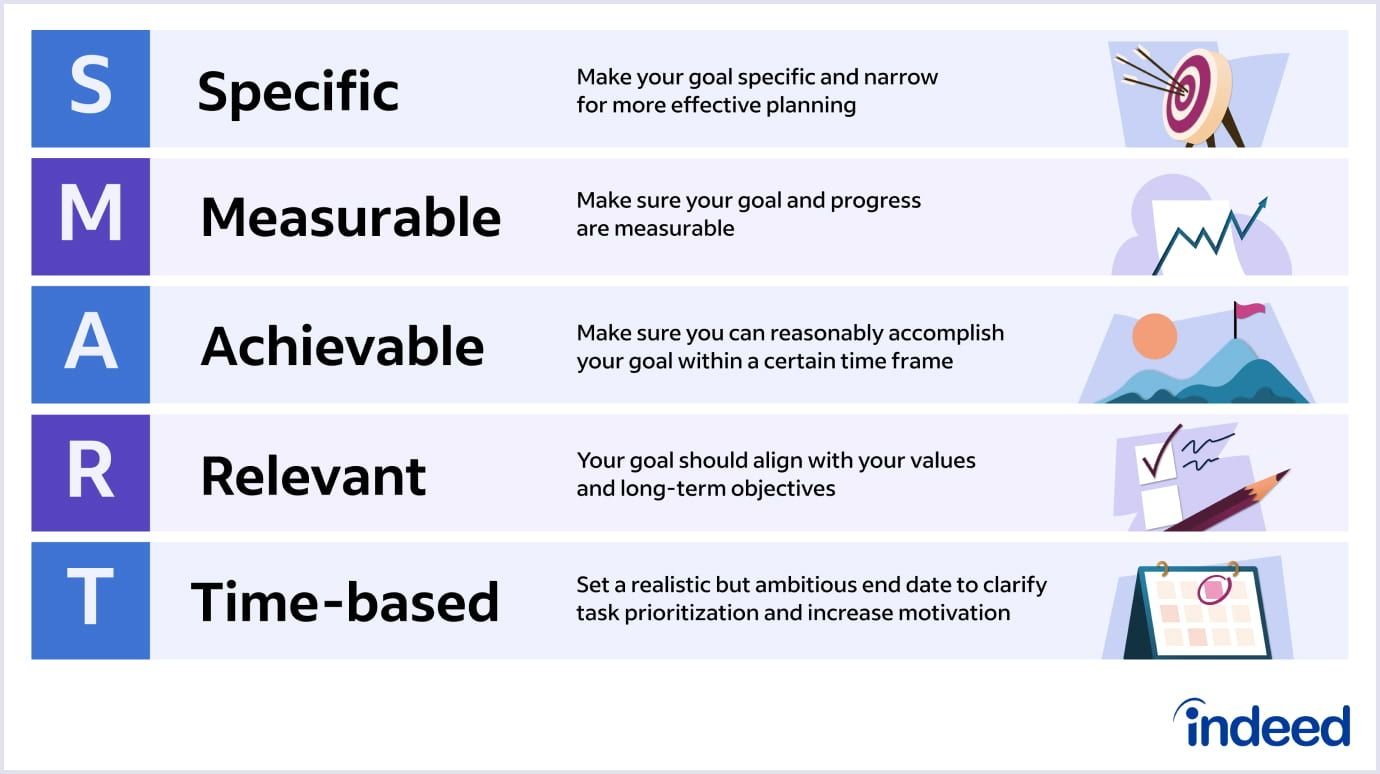
Features and initiatives
This part encompasses the filling of the future roadmap. For instance, it includes features, enhancements, or projects that are planned for development.
For easier management, they often have different labels. Use color coding or labels to distinguish between different types of items (e.g., new features, bug fixes, technical debt). Alternatively, they can also be grouped by categories, such as core functionality, user experience improvements, or technical upgrades.
Another vital roadmap feature is the division into milestones. Your roadmap should effectively depict when each feature or initiative is expected to be delivered. Thus, you can have different milestones like alpha and beta releases, sprint cycles, and estimated release dates.
Timeline
Depending on the features you are planning to enlist, you can choose from several types of visual representations and timelines. So, to convey the information effectively, you can try implementing one of the three most popular types.
A classic timeline roadmap
It provides a clear view where parts of it are placed in chronological order. They can overlap, yet with different labels, they are easy and understandable to track.
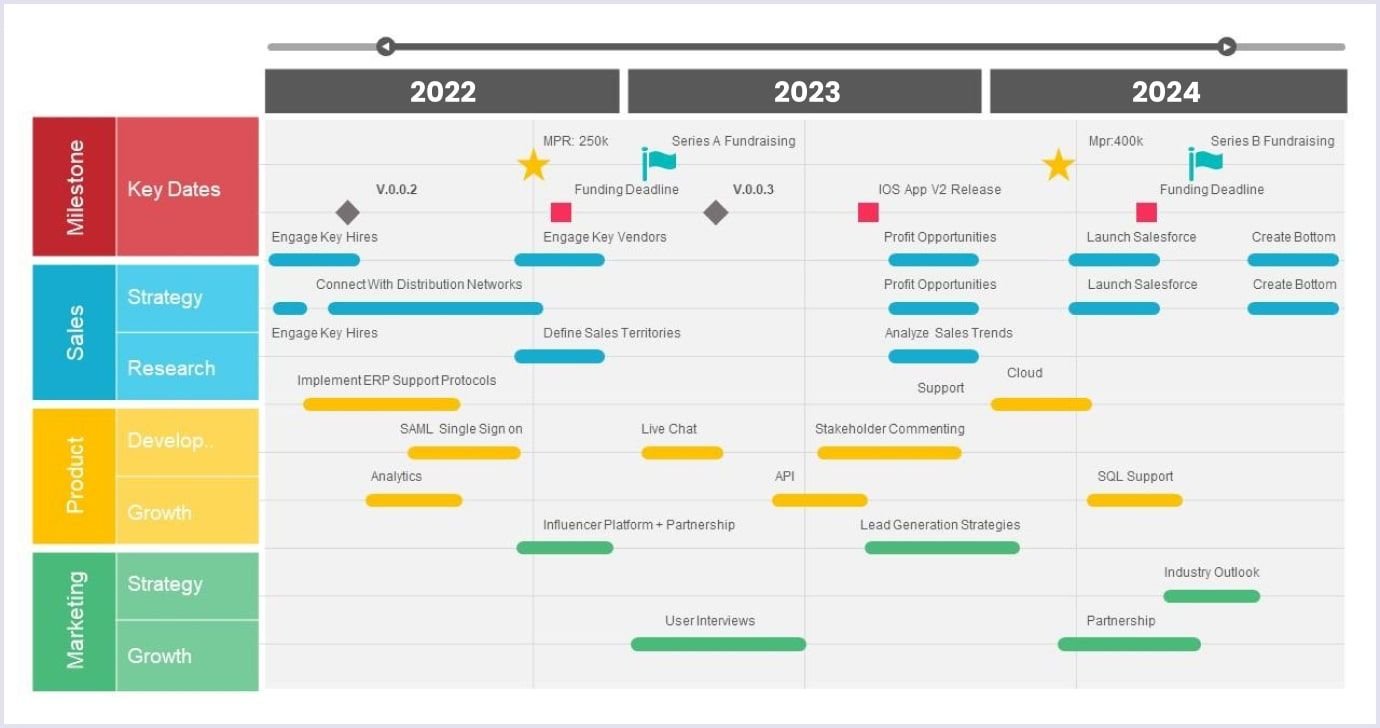
Gantt chart
It is a different beast. It may still be a good choice for your product development strategy, but it is a different tool with particular distinctions from a classic roadmap.
According to ProductPlan’s comprehensive comparison, a Gantt chart has two distinctive traits:
- It represents a linear schedule;
- It captures task dependencies.
Accordingly, in layman’s terms, a Gantt chart helps a team set a plan that details how they will complete a project. A roadmap, in turn, will help them define and communicate why they should complete it.
Swimlane diagram
In essence, the swimlane diagram serves as a blueprint delineating the responsibilities and deadlines assigned to each team member within a specific workflow. This visual tool draws inspiration from the lanes found in a swimming pool, expanding both horizontally and vertically to signify ownership of various tasks throughout the process.
Within a swimlane diagram, these lanes can represent not only individual team members but also encompass broader entities such as workgroups and departments. It's important to note that these entities can be either internal or external stakeholders involved in the process.
One of the key functions of a swimlane diagram is to vividly show who holds responsibility for each sequential step within the process. It also often uses arrows connecting processes to create a visual guide, illustrating the flow and transfer of information from one stage to the next.
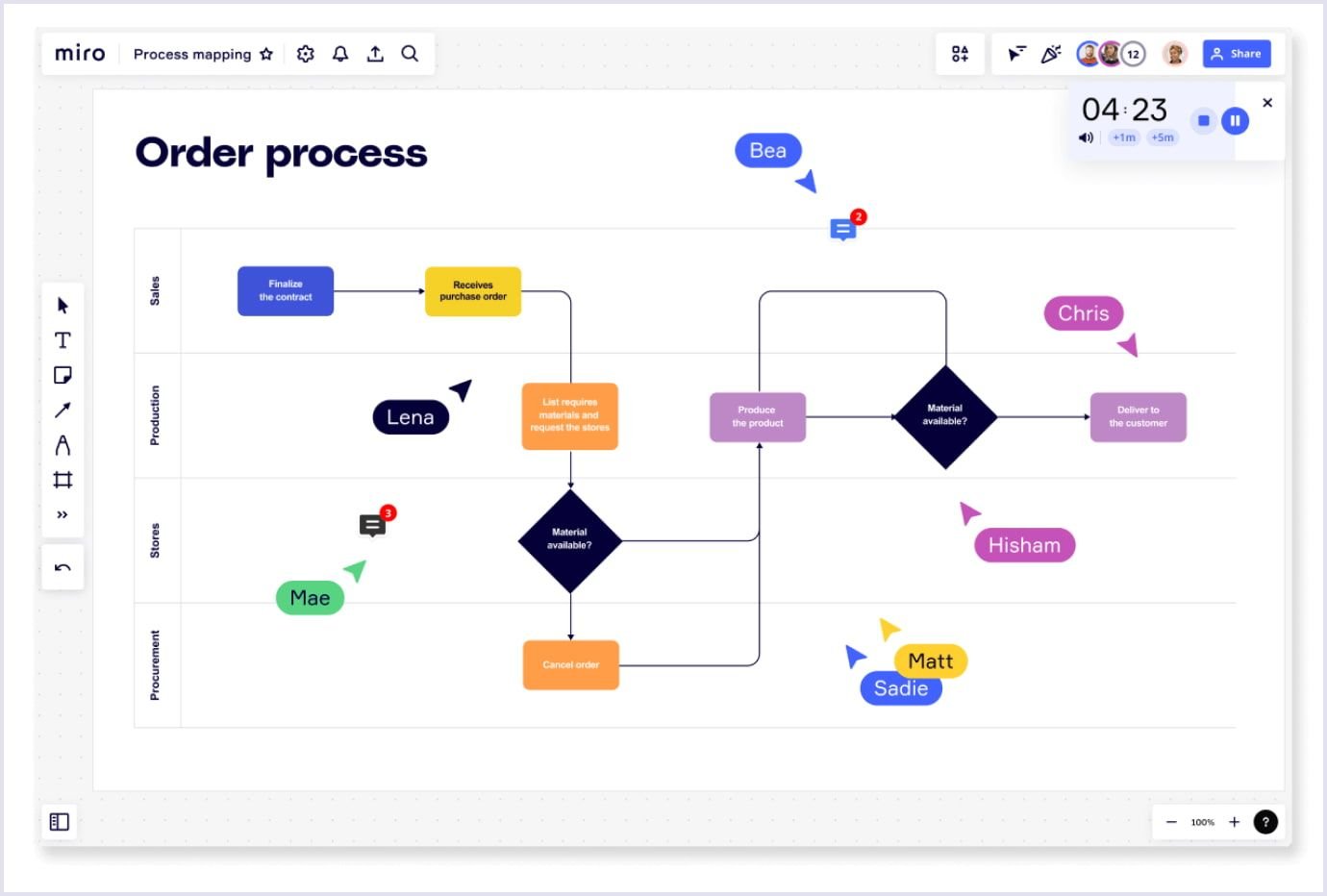
Prioritization
Roadmaps encompass many processes, and mindfully set priorities are very important. They help the team focus on the most critical tasks and allocate resources accordingly. It's not merely about choosing what to work on; it's about ensuring that your limited resources are allocated to the most impactful and strategically aligned endeavors.
To take advantage of prioritization, you can apply the following tips.
- Create different time horizons (e.g., short-term, mid-term, long-term) to maintain focus and flexibility. Each horizon will need a different approach, and you will be able to control them effectively.
- Come up with factors that make you prioritize certain features over others. For example, consider strategic alignment, business value, technical feasibility, and customer impact.
- Apply numerical or qualitative scoring to each feature or initiative based on your earlier chosen factors. This scoring system can help objectively rank and prioritize items. Product roadmap tools like the MoSCoW method (Must-haves, Should-haves, Could-haves, and Won't-haves) or the RICE scoring model (Reach, Impact, Confidence, and Effort) can be valuable in this context.
- Do not avoid collaborative decision-making. Prioritization is rarely a one-person task. So, instead, involve cross-functional teams, including product managers, engineers, designers, and key stakeholders, in the decision-making process. Collaboration ensures that diverse perspectives are considered.
Developing a prioritization framework
Another good tactic is to develop a prioritization framework. With its help, you can quickly analyze new parts of the roadmap, assess their importance, and set clear deadlines. In order for it to work as a blueprint, you need to settle certain important parts.
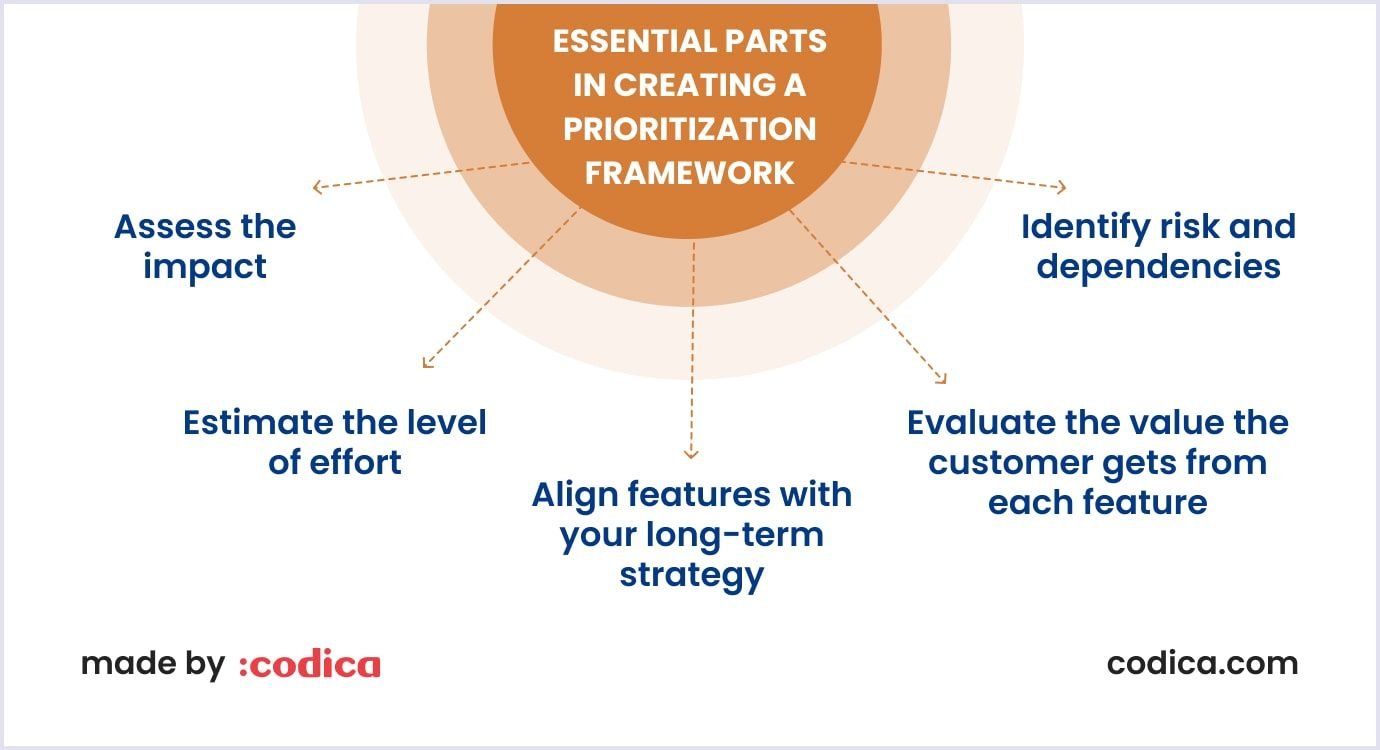
Impact
Assess the potential impact of each feature or initiative on your product's success. Consider how it aligns with your overall objectives and customer needs.
Effort
Estimate the level of effort required for implementation. This includes development time, resources, and any technical complexities.
Strategic alignment
Ensure that the selected features align with your product's long-term strategy and vision. Will they contribute to your overarching goals?
Customer value
Assess the perceived value that each feature brings to your customers. Does it address critical pain points or deliver significant benefits?
Risks and dependencies
Identify any risks or dependencies associated with each feature. Are there potential roadblocks or uncertainties that could affect implementation?
Feedback, communication, and iteration
Being the last parts of the product roadmap, any product roadmap example will prove that these aspects are no less important. Thus, you cannot simply create it and know for a fact that it works perfectly. Instead, you need to collect the feedback, learn how everyone involved should communicate about it, and what aspects you can tweak to improve it.
So, what can you do?
- Create a feedback mechanism. Incorporate a mechanism for collecting feedback and input from stakeholders, customers, and team members. Regularly updating the roadmap based on feedback ensures it remains responsive to evolving needs and priorities.
- Develop a communication plan. Outline how the roadmap will be communicated and shared with various stakeholders, including team members, executives, customers, and partners. Effective communication is essential for alignment and buy-in.
- Always consider flexibility. Recognize that a product roadmap is not set in stone. It should be flexible and subject to iteration as circumstances change, new information emerges, or priorities shift. After all, it's a dynamic document that should adapt to the needs of the business and customers.
In the aftermath, note that building a product roadmap is an ongoing process that requires collaboration, adaptability, and a deep understanding of your product's purpose and objectives. By following these steps and regularly revisiting and refining your roadmap, you can effectively guide your product toward success while staying responsive to changing market dynamics and customer needs.
Product roadmaps importance
Product roadmaps serve as a conduit through which the product strategy is transformed into actionable plans. They distill numerous competing priorities into a core set of priorities.
Now that we've covered how to create a product roadmap let's delve into why they hold such significance. Essentially, they serve as wellsprings of inspiration, motivation, and a sense of collective ownership over the product and its achievements.
Product roadmaps are unique in that they are among the few elements that nearly everyone within an organization encounters. Unlike sales pitches, marketing strategies, or financial plans, which are typically kept confidential, the product roadmap offers most employees their sole glimpse into the product's and the company's future direction. They foster a shared, mutual comprehension of the vision, goals, and objectives throughout the entire company.
Moreover, product roadmaps are pivotal in preventing chaos, ensuring that personal projects don't infiltrate the implementation queue, and safeguarding resources from being squandered on less vital tasks. They function as beacons, focal points, and guiding posts for everyone involved in bringing the product to market.
For now, let's summarize four key advantages and their significance to you, whether you're a business owner, project manager, or simply an interested individual.
- Collaboration and clarity among cross-functional teams. The presence of a product roadmap encourages teams to focus their efforts on solving the most critical problems using the available resources. It promotes a valuable prioritization exercise.
- Alignment and enthusiasm for product strategy. A product roadmap serves as a tool to foster a shared understanding of your product strategy throughout your organization. It enables you to coordinate the efforts of various departments and oversee their activities.
- Continuous communication. These ongoing dialogues about the reasons behind, methods for, and individuals involved in the work to be carried out create a culture of alignment and a deep comprehension of the product's vision and direction.
- Visibility into strategy progress. An effective product roadmap instills confidence in stakeholders, investors, and customers by offering transparency into what's happening, evolving, or advancing within your company's strategy.
Best practices for the product roadmaps
There are various techniques and tips to max out the positive output from the roadmap. Some of them advocate focusing on communication, while others advise regularly updating the roadmap. In any case, here are several practices to make the most of your roadmap.

1. Maintain an updated roadmap
Roadmap development is not a one-time project. Instead, it is crucial to update the roadmap regularly. Many of today’s projects undergo serious changes in short periods of time as the market always changes. When you neglect to update it, you risk misinformation and chaos within your team. Your product team may lose direction, and other departments will become increasingly confused.
On the external side, looking from the outside, stakeholders, users, and investors rely on product roadmaps as they allow them to see where the product moves. Failing to update the roadmap may result in severe losses for investors, unwanted outcomes for users, and reputational damage to stakeholders.
The frequency of roadmap updates depends on your company and product stage. In the early stages, consider two primary approaches.
- On the one hand, conduct regular reviews. Essentially, it implies reviewing the roadmap routinely, even without making changes. It can be done weekly, monthly, or at another interval, just to make sure everything stays on track.
- On the other hand, you can opt for immediate updates. Make it a standard practice to add any action items decided upon in meetings or documents to the roadmap promptly. This prevents items from being overlooked and causing confusion for other departments or customers.
In any scenario, consistently updating your roadmap eliminates confusion and ensures that important tasks are not overlooked.
2. Adhere to consistency
Although there are lots of tools to create compelling roadmaps, consistency in format and content is key. Accordingly, it should be agreed within the team on a standard format for entries. Whether it's the way items are added or the level of detail provided, ensure that your roadmap maintains a consistent appearance and content structure. With a consistent agenda, you will easily avoid confusion and provide the right information to the reader.
Also, it is important to maintain balance in what you are presenting within the roadmap. Otherwise, you can be met with two unpleasant scenarios:
- A lack of crucial information. It can cause communication problems and gaps.
- An excess of redundant information and details. Utterly detailed roadmaps may confuse readers unfamiliar with all the project’s details and peculiarities.
3. Define ownership and access levels
Being more specific to internal product roadmaps, it's crucial to assign clear ownership for each item. This approach will ensure everyone knows who to contact in case of issues or questions, preventing a bottleneck of inquiries directed at the general product manager.
A clearly visible ownership within the roadmap also fosters a sense of responsibility and pride among those responsible for specific tasks. However, applying this practice differs from team to team as companies use different team structures to increase performance and meet the employees’ expectations.
4. Avoid creating false expectations
People love roadmap planning, and adding items to them can be exciting to the extent that you forget about responsibilities. Thus, it is essential to maintain realism. A product roadmap should display exclusively achievable goals, and it’s this trait that makes it valuable.
Take careful consideration of the scope of each item you include and whether it's feasible. If something isn't realistic, don't include it in the roadmap. If something is uncertain, you can always rely on a feedback mechanism, create surveys, and ask people. Once approved and decided, only then display your plans on the roadmap.
Remember that customers and team members may initially be thrilled to see your plans, but disappointment arises when timelines slip, or promises aren't fulfilled. Consistently letting people down erodes trust, which should be avoided at all costs. After all, it is always wiser to underpromise and overdeliver.
Bottom line
In the aftermath, after figuring out what is product roadmap, it’s worth noting that they are completely seizable. They are neither difficult to create nor complicated to manage. Instead, they are just complex, involving many different aspects.
We sincerely hope that this article sheds more light on how roadmaps work from the inside. After all, we looked at their different types, the creation processes, and even best practices that can help you handle this document.
In Codica, we regularly overview, comment, or simplify many various aspects of custom software development. Thus, feel free to find out more about what interests you the most in our blog. Also, if some questions remain unanswered, you can always contact us.

